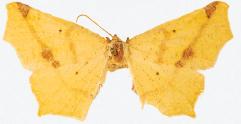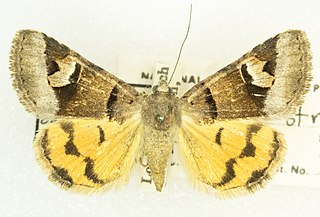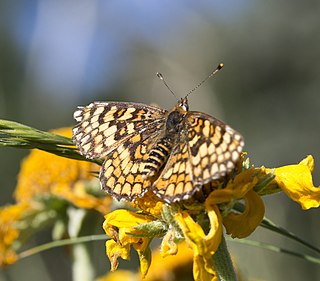
William Henry Edwards was an American businessman and entomologist. He was an industrial pioneer in the coalfields of West Virginia, opening some of the earliest mines in the southern part of the state. He was also a prominent naturalist specializing in the study of butterflies. He wrote The Butterflies of North America, a three-volume treatise that is highly regarded for its scholarship and the quality of its illustrations.

Colias is a genus of butterflies in the family Pieridae. They are often called clouded yellows in the Palearctic and sulphurs in North America. The closest living relative is the genus Zerene, which is sometimes included in Colias.

Acontiinae is a subfamily of bird dropping moths in the family Noctuidae. There are more than 50 genera and 430 described species in Acontiinae, found worldwide in temperate and tropical climates.

Urodidae, whose species are commonly known as false burnet moths, is a family of moths in the lepidopteran order. It is the type genus in the superfamily, Urodoidea, with three genera, one of which, Wockia, occurs in Europe.

Cirrhophanus is a genus of moths of the family Noctuidae. The genus was erected by Augustus Radcliffe Grote in 1872.

Drasteria is a genus of moths in the family Erebidae.

Eulithosia is a genus of moths of the family Noctuidae erected by Henry Edwards in 1884.
Hoplolythra, erected as a moth genus by George Hampson in 1910, is now considered a synonym of CirrhophanusGrote, 1872 by Butterflies and Moths of the World or of EulithosiaH. Edwards, 1884 by Lepidoptera and Some Other Life Forms.

Syngrapha is a genus of moths of the family Noctuidae.

Antepione is a genus of moths in the family Geometridae, the geometer moths. The genus was described by Packard in 1876. They occur in North and Central America.

Aspitates is a genus of moths in the family Geometridae, native to Eurasia and North America.

Drasteria perplexa, the perplexing or perplexed arches, is a moth of the family Erebidae. The species was first described by Henry Edwards in 1884. It is found in North America from Alberta and Saskatchewan south to Colorado and Arizona.

Antepione imitata is a moth of the family Geometridae first described by Henry Edwards in 1884. It is known from western Texas, Colorado and New Mexico to southern Arizona and is probably also found in northern Mexico. It is generally associated with riparian canyons up to 1,830 meters.
Streniastis composita is a moth in the family Gelechiidae. It was described by Edward Meyrick in 1922. It is found in Australia, where it has been recorded from Queensland.

Stiriini is a tribe of owlet moths in the family Noctuidae. There are about 16 genera and more than 90 described species in Stiriini.

Cecrita lunata is a species of moth in the family Notodontidae. It was first described by Henry Edwards in 1884 and it is found in the western United States and Mexico.

Poladryas arachne, the arachne checkerspot, is a species of crescents, checkerspots, anglewings, etc. in the butterfly family Nymphalidae.
Eulithosia discistriga is a species of moth in the family Noctuidae.

Eulithosia plesioglauca is an owlet moth. The species was first described by Harrison Gray Dyar Jr. in 1912.

Chalcopasta territans is a moth in the family Noctuidae first described by Henry Edwards in 1884. It is found in North America.













